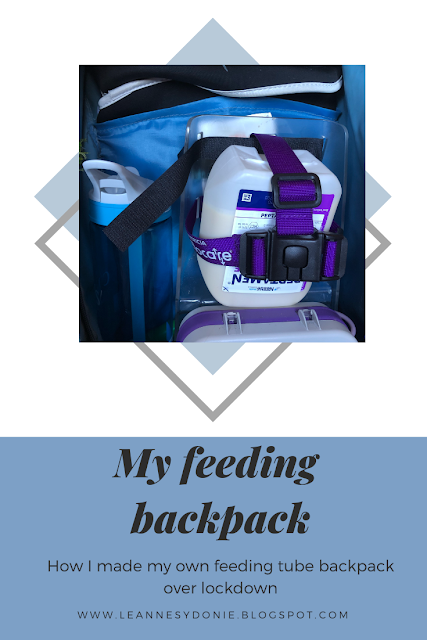Making my own Feeding Tube Backpack
My lockdown projects started off as the usual: cross-stitch, reading, and curling up in bed completely terrified of the outside world. I cross-stitched a couple of cute Baby Yodas, read a few biographies, and barely left my room due to the strict shielding guidelines. I cleaned and redecorated my room a little, gave away furniture, and was really just feeling a bit lost.
Then I started a few volunteering projects which I threw myself into fully, replacing my part time job and physical volunteering roles I was supposed to be returning to.
But somewhere between these tasks, I decided to make my own feeding tube backpack.
Before I go into it, Ceara (@cc.sparkle on tiktok) who has been really unwell recently released a super relevant video [my feeding tube backpack collection] discussing her own feeding tube/IV infusion backpacks. She uses completely ordinary bags and places her equipment in, and it just emphasises that you absolutely do not need the bells and whistles of a feeding tube backpack, which is often just… a hole in the back. Please check it out and give her some support! For any American readers, Ceara is also running a virtual blood drive, you can pledge to give blood at Ceara Strong and if you're eligible to donate blood, please do! with the covid lockdown, many blood banks have been close to running out of their blood supply that is crucial for so many people, including Ceara.
The reason I decided to make my own feeding tube backpack is the same as a lot of people want to buy one: the backpack you get, and I have to carry all day every day, is super medical. But my Nutricia backpack is TINY, and can hold the ‘car seat’, but no big purse etc.
The good thing about the backpack I was given was a number of things: the bottle holder, the zipped pocket, the bit that opens to show you just the pump, and the little pocket inside which I use to hold my medical letter in case of any emergencies, so that people can know why I’m tube fed. Apart from that, it wouldn’t hold anything!
As a university student, I have to carry a laptop around campus, and the laptop I own is lightweight for this reason. It fit perfectly into my usual uni bag, but there was no way it would fit into my Nutricia backpack. My tube feed runs over 20 hours, I usually switch the feed on at night and then I can disconnect for a little bit of time the next evening. I’m probably not going to be disconnected from my feed at university, which means I either needed to carry a couple of different bags, the Nutricia backpack and something else, around with me, or I needed to get a new backpack.
Checking out the prices of adapted bags, they range around £40 to £60, minimum. And they’re cute, but extremely basic. It seems a waste for me to have a perfectly good backpack already, and then to buy another one for quite a big chunk of money. So instead of £40, I spent £10 on some supplies, and got on with adapting my own bag, for the first time.
The first thing I did was try on the bag with everything in it- my laptop, water, my feeding equipment, and the supplies I have to carry about just in case- like Ph strips, a syringe and dressings. I’m not going to lie, it’s heavier than the Nutricia backpack, which is weight balanced, but it isn’t heavier than my laptop and a couple of law textbooks. For wearing between lectures on my small campus, it was good to go.
 |
| My current setup, the 'car seat', an [empty] bottle and my laptop. Super Spacious! |
The bag I was adapting was my Kanken I had used at university. I chose my Kanken because it is the bag I had, and I’ve seen adapted ones before, but there was no way I was buying another one just to have a wee hole made in the back. My Kanken also has a really good front pocket that can be used to keep the essential supplies, a 60 ml syringe, dressings, pH strips and so on. Plus, I knew the basics of these adapted bags: a hole in the back, and something to hold the feed. In my Abbott bag the feed bottle was held with a clip from the top of the bag, and the pump was put in a padded area in the same section of the bag. The Nutricia one was a lot easier to work with- everything is contained in what looks like a car seat- a plastic seat where the pump sits below the feed container. On one of the adapted bag sites, it recommended hot gluing the Nutricia car seat in, but I didn’t want to mess that up, which was extremely likely. So, I looked at the design of the Nutricia backpack, which had the car seat held in with an elasticated strip of Velcro. Velcro I could do. I hand sewed a strip of Velcro to the middle of the main compartment, and in the part of the Kanken where I would usually hold my laptop, I stitched the Velcro through to the laptop sleeve to give the stitching a bit more strength, which took a whole day by hand, going through three different layers of thick fabric with a normal sewing needle!
 |
| The basic supplies, a sterile syringe, pH strips, a tubie clip [from Natstubies], and some straws. Also in this pocket is some dressings, tube caps and a pair of scissors! |
 |
| I had jabbed a needle into my hand a good few times after this stage, and it was exhausting! |
I then created a little hole in the fabric separating the main compartment of the Kanken. This was already ripped, but I stitched it to ensure that it wouldn’t really change shape or rip more. It isn’t too much of an issue that it was ripped, but this is just to ensure the tubing of the giving set can reach the little hole made in the back of the bag while keeping the compartments I prefer.
 |
| Keeping the hole in check... With some questionable stitching! |
The little hole in the back of the bag was my biggest issue. In the Nutricia and Abbott backpacks, the hole is elasticated, meaning that the tubing can get through but the hole is relatively small: meaning less water damage! Many adapted backpacks have a giant metal ringed hole that I would worry about water damage or things falling out. It also isn’t very discreet. I wanted my hole to be covered, but also large enough that the tube has freedom to move so doesn’t tug. I decided to cut a hole in the bottom part of the Kanken that is covered by the right strap, and stitched around this so that the bag didn’t rip any further. The hole is covered on the outside by the strap, and on the inside by the laptop sleeve, and although it isn’t elasticated, it is a lot more discreet than the metal ring of many other adapted bags.
I also bought a Carabiner clip in case when return to univer my feed company has to switch back to Abbott, and if so, I plan to glue some fabric in, and place the carabiner around it at the top to hold a bottle, but I haven’t put this in right now as I’m still currently, and it looks like the plan is to continue, using my current system.
Finally, I couldn’t rest without embroidering something on
it. I wanted to embroider my kanken anyway, and I probably will still embroider
the front. I put a little tube fed Baby Yoda poking out of the left bottle
pocket: a reference to the Baby Yoda meme my mam made me just after my tube was
placed. I think Baby Yoda really brings the bag together, personally!
 |
| I think I've drawn out this inside joke too far |
All in all, I probably wouldn’t have adapted a backpack by hand if we were not in lockdown- there is a multitude of things I would rather be doing, like going about my normal life. And from starting the project, abandoning it half way, and then finally finishing this week, it's taken a few months to finish. However, even though I’ve never stitched outside of cross-stitching and the basic stuff we learned at primary school, and I’m sure this job would have been 100 times easier with a sewing machine, I have to say I’m proud of it. My own blood and sweat went into stitching this bag myself, and it gives me a bit of my normal back. Instead of my medical looking, professional, but extremely small feeding tube backpack, I have my usual uni bag back. Which is kind of like reclaiming a little bit of my own life, in a way.
Leanne-Sydonie x



Comments
Post a Comment